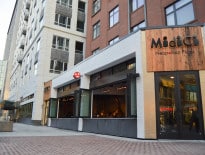
Nearly 100 acres where more than 16 million square feet of development are proposed at Suffolk Downs would be elevated two to four feet to protect new buildings and roads from storm surges.
Originally built on filled tidal creeks bordering the 241-acre Belle Isle Marsh, Suffolk Downs will become a living laboratory for resiliency in the age of rising seas.
Over 16 million square feet of residential and commercial space are proposed for the former thoroughbred racetrack property on the East Boston-Revere border, including a potential home for Amazon’s second headquarters.
For owner-developer HYM Investment Group of Boston, the challenges of building the city’s largest development in a high-risk environment appear surmountable. HYM is planning to use emerging building and site strategies to buffer superstorm surges and minimize stormwater runoff generated by dozens of new roads, office towers and residential buildings.
“There will never be a time in the lives of our children or grandchildren where the site will be underwater,” said Thomas O’Brien, HYM’s managing director. “But there will be increased possibility of flooding, such as a Superstorm Sandy that could happen in Boston, and we have an obligation to adjust the site to make it work.”
Coastal developments’ vulnerability was underscored on Jan. 4 when winter storm Grayson hammered Massachusetts, inundating portions of the Seaport and Rose Fitzgerald Kennedy Greenway and flooding the entrance to the MBTA’s Aquarium station.
Yet preparing for climate change remains largely the responsibility of private developers, as current building codes don’t require specific resiliency measures. The Boston Planning and Development Agency recently updated a resiliency checklist that it requires sponsors of major developments to submit, but does not specifically regulate mitigation.
“The unfortunate thing is we do not have any mandates for climate adaptation at either the state or local level,” said Deanna Moran, director of environmental planning for the Boston-based Conservation Law Foundation.
Nonetheless, some developers have voluntarily adopted aggressive resiliency strategies in recent years. Lend Lease elevated ground floors three feet above FEMA flood map guidelines at its 477-unit Clippership Wharf condominium development under construction in East Boston.

Steve Adams
Vast Site Offers Advantages
More specifics on Suffolk Downs will be revealed in filings this spring, but HYM already has made resiliency a priority. In a first for one of the region’s most-active developers, it’s added a resiliency consultant to its project team in the form of Ann Arbor, Michigan-based LimnoTech.
At 161 acres, Suffolk Downs’ size is a unique advantage, O’Brien said, enabling much of storms’ effects to be mitigated on site. The planned stormwater management system will replace a rudimentary drainage system dating back to the 1930s.
Approximately 40 acres running through the heart of the property are designated as open space, and will double as temporary drainage areas during superstorms. So will the 1-acre ornamental pond built in the racetrack’s infield in 1938.
Capable of holding stormwater for 72 hours on-site, such measures are designed to handle a 100-year storm bringing nearly 9 inches of rainfall in 2100, according to project filings. Designs also take into account the likelihood that sea levels will rise more than three feet by 2100, based upon the Climate Ready Boston report released in 2016.
A tide gate owned by the state Division of Conservation and Recreation on Bennington Street holds back tidal flows onto the property, and keeping the tide gates operational is a key defense against coastal flooding, O’Brien said. Office and residential buildings will be equipped with living roofs and stormwater recycling systems to minimize new runoff from structures.
Nearly 100 acres where buildings and roads will be built will be filled to raise elevations two to four feet, placing them above projected flood plains for a 100-year storm. Building elevations would be determined on a case-by-case basis, but the first 500,000-square-foot office building which could break ground late this year was designed at 40 inches above the 100-year FEMA flood elevation.
“The science is complicated, but the concept is simple,” O’Brien said. “Our idea is we’re going to make the site a shelter-in-place site, as opposed to other coastal sites subject to evacuation.”
Environmental watchdogs say HYM is taking the right approach, given the evolving research into resiliency strategies. But they also warn of a lost opportunity if the development isn’t designed and reviewed with focus on neighborhood-wide impacts.
The lowest elevations on the property border the MBTA’s Beachmont Station in Revere, which was forced to close for approximately an hour during Storm Grayson because of flooding, said Jill Valdes Horwood, director of waterfront policy for Boston Harbor Now. That points to the need for coordination with agencies such as DCR and the Boston Water and Sewer Commission on limiting the effects on nearby residential neighborhoods, she said.
“That’s going to be the next big topic of conversation: how climate resiliency planning can benefit not just the actual development, but the Boston and Revere communities around the Suffolk Downs site,” she said.
CLF’s Moran said more study is needed into Belle Isle Marsh’s ability to absorb runoff as sea levels rise.
“Introducing the level of development they’re proposing, there unavoidably will be a significant amount of impervious surfaces and that has implications for the site’s ability to store flood waters,” she said. “This is an opportunity for Suffolk Downs to be an incubator for climate-resilient design and a real-life pilot in Massachusetts of what’s possible on a large scale.”




 |
| 
